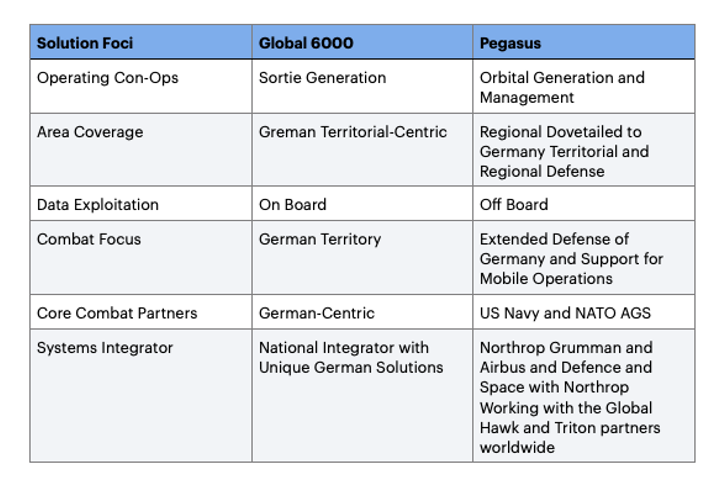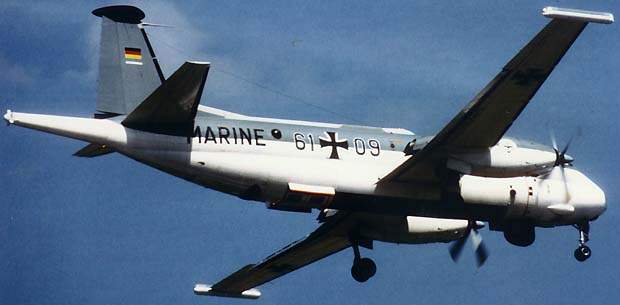By Robbin Laird
With the US Navy’s FMS Offer to Germany for Triton having expired without being extended, Germany is now pursuing a manned aircraft alternative for the SIGINT mission.
The approach would be to buy three Bombardier G6000 aircraft and equip them as special mission aircraft.
Germany already has Bombardier G6000s in its inventory, as VIP aircraft.
What little press there has been about this alternative suggests, that this will be a lower cost solution and able to make the NATO commitment by 2025 to provide for Germany’s contribution to the SIGINT mission.
An article by Jhon Lake published on January 29, 2020 by AINonline, highlighted the argument for a new alternative:
It has been reported that the Triton plan had grown “significantly more expensive” compared to German planning assumptions, while there were growing concerns that full European Union Aviation Safety Agency (EASA) certification was going to be difficult to achieve within the required timescale.
Experience with the similar Global Hawks used by NATO’s new Alliance Ground Surveillance fleet, stationed in Sigonella, Sicily, led the German Ministry of Defence to conclude that it was unlikely to be able to meet the safety standards required for flying in European airspace by 2025, and would be subject to onerous restrictions that required it to fly only in segregated airspace and dedicated corridors.
Bandwidth constraints—and the growing problem of GPS and datalink jamming and disruption—may also have influenced Berlin and prompted it to look again at a manned platform with onboard analysis capabilities. It may be no coincidence that no major air force has deployed a UAV platform in the strategic Sigint role.
Production of the Global 6000 is drawing to a close, and Berlin will have to move quickly if it is to obtain the aircraft it requires. The Global 6000 already forms the basis of a dedicated Sigint platform for the UAE Air Force (two aircraft having been converted by Marshall Aerospace in the UK), while Turkey is converting another four to Hava SOJ (stand-off jammer) configuration.
But how comparable are the two solution sets?
And are the projected cost savings realistic and is the ability to deliver a manned SIGINT capability by 2025 realistic?
The basic challenge posed by comparing the two systems is rather obvious – these are two very different system solutions, with very different capabilities, which can provide for very different approaches to concepts of operations.
I would like to compare the two platforms from the standpoint of delivering very different systems outcomes and providing very different contributions to concepts of operations.
The table below highlights a number of aspects which I think provide a way to do such a comparison.
I will address in a later article the question of networks, and enablement of German and allied forces able to leverage the data provided by the two very different solution set approaches.
The first element of comparison involves the operational concept of operations.
The Global 6000 is a manned aircraft and will operate within a sortie generation cycle. This means that get continuous coverage in the combat radius area the Bundeswehr deems as necessary will require air crews and planes sufficient enough to keep it airborne continuously in times of crisis.
This will be a clear cost driver beyond the notion of simply buying three initial aircraft and crewing and sustaining those three aircraft.
Any realistic cost projection must take this dynamic into account.
The Pegasus which is a German variant of Triton operates very differently.
Triton’s persistence at long range lends itself to a concept of operations which facilitates a continuous orbit at 3000km, a platform requirement the Bundeswehr set at the initiation of the program.
This year I have had a chance to discuss this orbital con-ops approach with Navy officials and operators.
The point is that operational experience is already being generated which the Bundeswehr are able to leverage.
As I argued in an article on the Triton and its contribution to shaping the kind of ISR which the U.S. and its allies require for the high-end fight:
“For full value to be derived from the Triton fleet, a kill web mentality will have to replace what has been a sortie generation mentality for the carrier fleet. It is about building in an orbit-enabled concept of operations, rather than thinking of the aircraft in sortie-generation concepts of operations.
“What this means is that for the Navy to get full value out of its Triton force… means embracing what a high altitude remotely piloted vehicle with a sensor package which can help build a common operational picture generated by orbits can provide for a kill web strike force, which may well operate within a sortie-generated concept of operations, which the orbiting high altitude asset will provide.
“With a four ship 24/7 coverage of the area where you will operate or wish to operate, the Triton can provide domain knowledge crucial to informing both the threat and opportunity calculus in an area of operations.
“And because the orbit is not about sorting into a specific area, one can sort through where the best advantages might lie for the projection of force without tipping your hand by having to fly to a specific tactical area.
“This is a work in progress, but it is a new capability which if fully embraced provides significant warfighting advantages to the United States and its allies.”
These differences in operating con-ops leads to the second and major difference between the platforms, namely, their area coverage.
Triton’s onboard capabilities, range, altitude and efficient operating cycles will provide significant regional coverage and early warning for German forces of enemy threats and intent in real time.
These vast improvements in situational awareness will allow German armed forces and political leaders to tailor military and diplomatic responses during peacetime and crisis, improve Bundeswehr survivability, while providing critical ISR data to NATO partners.
With limited operational combat assets, it is crucial to be able to ensure, that your force goes to the right place, at the right time, and to deliver the desired combat effect.
Reducing area coverage is hardly a smart move strategically, tactically, or financially.
But that is precisely what a shift from Pegasus to a manned platform would do.
The third difference is with regard to data exploitation.
The Global 6000 is built around data exploitation and operators onboard.
Not only does this put Bundeswehr soldiers in harm’s way, the size of the aircraft is a problem in terms of limiting the number of stations onboard to do data exploitation.
Likewise, the ability to off-board time sensitive ISR data to decision makers and users on the ground is limited in a G6000 Concept of Operations.
In comparison, Triton’s satellite communication architecture allows off-boarding of Pegasus information from anywhere in the world to various ground sites in near real time, facilitating more rapid exploitation and dissemination of data than a manned solution.
And with the advances in big data management and exploitation, the computational power and AI enablement coming to the ground operators will allow for rapid change in how data can be exploited and delivered.
This includes data fusion with other sovereign and NATO ISR assets including Euro-Drone, NATO AGS, and FCAS to develop a richer and more accurate picture of the battlespace.
The recent airworthiness criticisms have always been puzzling because the Chief of Defense approved the Auswahlentscheidung (AWE) for Triton in 2017 based on significant coordination, mutual recognition and Luftfahrtamt der Bundeswehr approval of the USN airworthiness process.
Likewise, Triton flies at altitudes well above manned traffic and includes some of the most capable U.S. technology and safety features for integrating UAS with manned aircraft.
The German PEGASUS variant was planned to have additional capability to meet the European Airspace requirements.
The fourth comparison is the question of where combat will occur and how best to support it.
If this were the Cold War, a manned solution to SIGINT would make sense as it would be about reinforcing the German defensive bulwark.
That bulwark is gone, and the immediate combat threats and requirements will occur in Germany’s neighborhood.
The challenge will be to take the limited German military assets and move them to the point of maximum effect as rapidly as possible.
Regional coverage is the priority, tailorable to the national force and territorial defense.
The fifth aspect really revolves around the kind of combat learning crucial to be effective.
With a unique German solution, the challenge will be to integrate into NATO forces.
With the Pegasus solution, interoperability is assured given the impact already of Triton on the US Navy and the impact of the AGS remotely piloted aircraft on NATO as well.
With a common system, PEGASUS can realize regional basing, training and logistics synergies with NATO AGS, USAF Global Hawk, and USN Triton at Sigonella, IT and other regional deployed sites.
The AGS Mobile General Ground Station (MGGS) built by Airbus is the core component for data dissemination with NATO and Partner Nations.
For the PEGASUS ISIS Mission System, Airbus evaluated elements of the MGGS system that would be utilized for the ISIS Ground Station, resulting in improved interoperability with AGS.
The sixth flows from the fifth.
The Global 6000 solution will be led by Hensoldt, a company which has never previously performed complex aircraft integration work, and a company that is expected to be up for sale in the near future, as its KKR investors seek to recoup its investment.
This means that with little doubt that program and technical risks will increase Global 6000 program costs with the promise of significant cost saving compared to the Pegasus solution very problematic at best.
With a direct commercial contract to Hensoldt, there is no certainty that the final development costs of the G6000 will provide any cost savings, compared to the PEGASUS cost estimates.
As a comparison, the recently announced acquisition of 3 Triton Aircraft, 2 Main Operating Bases (MOB), and one Forward Operating Base (FOB) by Australia, was reportedly contracted at $333M, whereas the German Parliamentary approval for 3 unmodified G6000 aircraft is estimated at $890M.
This G6000 cost does not include the Mission System and Integrations costs.
This brings into question, if the German MoD accurately portrayed the cost differences of these 2 systems.
And as mentioned above with regard to area coverage, there is really no comparison to what Pegasus can deliver and what Global 6000 will deliver.
This means that SIGINT mission requirements must be reduced to what the Global 6000 platform can perform, rather than focusing on the real combat situation facing the Bundeswehr today.
There is a reason the US Navy has selected Triton as the mainstay of its future SIGINT capability, equipping the entire fleet to replace the manned EP-3 in the 2020’s.
In short, these are two radically different solution sets.
Pegasus aligns with the evolving strategic environment and the innovative approaches being taken by the U.S. and its allies with regard to force modernization; Global 6000 does not.
The featured photo: The German Navy’s Breguet 1150 Atlantique.
For some time, the German Ministry of Defence has been seeking its Signals Intelligence replacement for its last platform to play such a role, the modified Breguet 1150 Atlantique.
For the terms of reference for the series:
Platforms, Concepts of Operations and Defense Decisions: The German Case
For the first article addressing the German SIGINT decision:
German Platform Decisions: Selecting an Airborne SIGINT Platform


